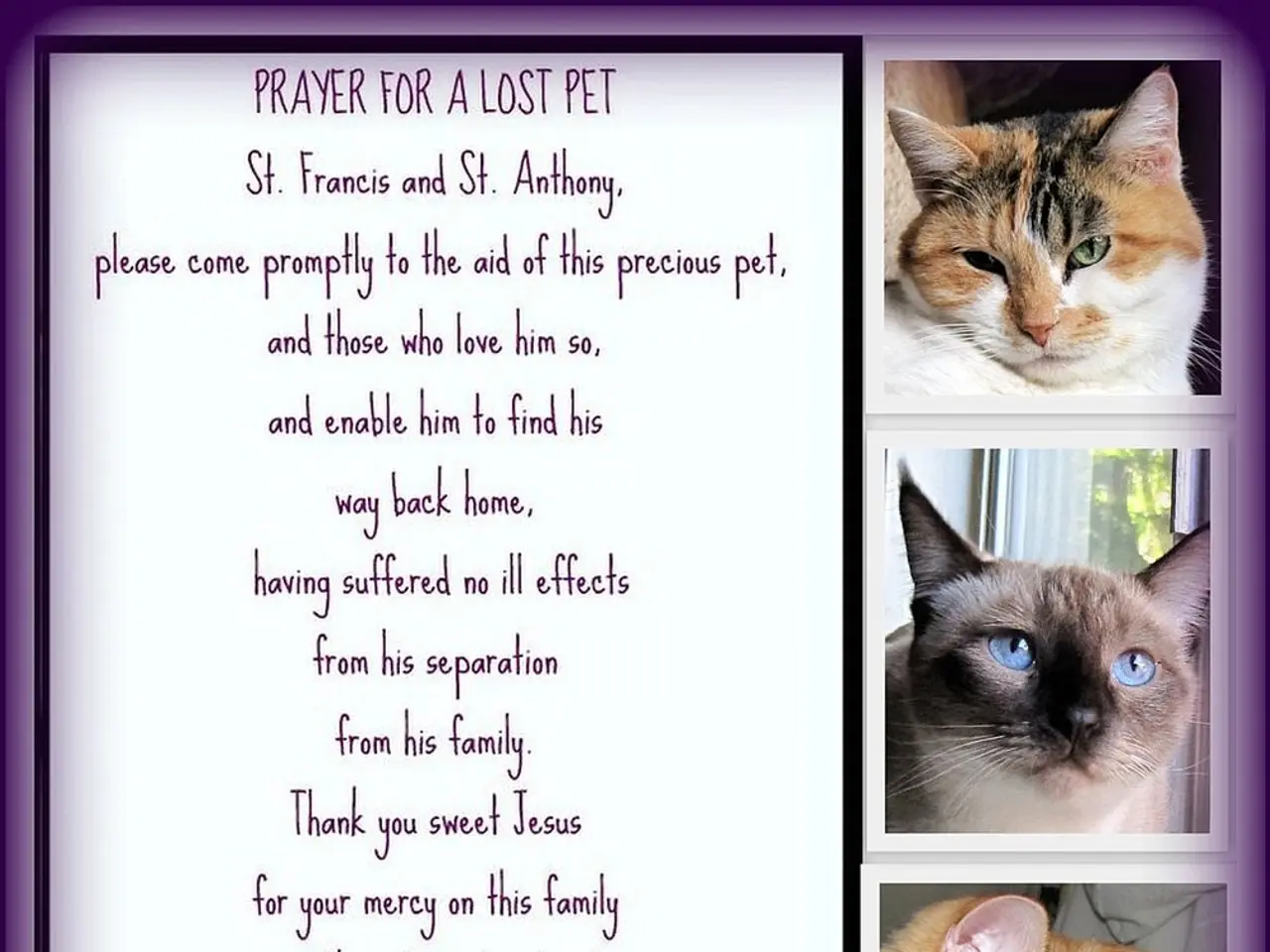Interpreting a Cat's Happiness: Insights from a Feline Behavior Specialist
In a fascinating development, scientists are making strides in understanding how cats express their emotions through their faces and body language. This newfound knowledge can help cat owners better understand their pets and strengthen the bond between them.
One key tool in this endeavour is the feline grimace scale, which includes changes in the muzzle shape, the position of a cat's ears, a narrowing of the eye area, and the whiskers being forward, straight, and away from the face. These subtle cues can reveal a cat's emotional state, from contentment to distress.
A cat in distress may lower its head, with the chin tucked close to the chest, or show signs that it wants you to stay away. These signs include a swishing tail, rippling skin, a flattened body, limbs and tail tucked in close to the body, hissing, spitting, caterwauling, and attempts to escape.
On the other hand, a relaxed cat often displays different signs. A slow blink from a cat signifies a relaxed state, while a rapid blink with scrunched-up eyes indicates fear. A cat who is lying on its side or its back with legs stretched out, tail loose and out, and belly on show is also a sign of relaxation.
To accurately read and interpret a cat's body language and facial expressions, it's essential to observe multiple signals in context. Cats communicate complex emotions through subtle physical cues. Here are the key elements to focus on:
1. Tail Position and Movement: A high-held tail indicates confidence and happiness, while a tucked tail suggests fear or submission. A tail flick or swish can indicate irritation or excitement, depending on the context.
2. Ear Positions: Ears facing forward show curiosity, contentment, or interest, while flattened ears indicate threatened, scared, or irritated feelings.
3. Eye Contact and Blinking: Slow blinking is a sign of trust and affection, often called a "cat kiss" and indicates relaxation and security. Dilated pupils can show excitement, fear, or aggression depending on the situation. Direct stare may be a challenge or threat, while looking away or blinking can be calming signals to avoid conflict.
4. Overall Body Posture: A relaxed body with soft muscles indicates content and comfort, while a tense, crouched posture shows fear or defensiveness. An arched back, fur standing on end indicates fear or aggression. Pouncing or playful gestures can be playful or aggressive depending on the context—pay attention to the surroundings and interactions to understand the meaning.
5. Facial Expressions and Whiskers: Whiskers pushed forward often mean curiosity or alertness, while whiskers pulled back may indicate fear or unease.
6. Additional Behaviours: Face rubbing or head bunting is a sign of affection and marking you as part of their social group. Meows with different tones can indicate attention-seeking or pain or distress.
To accurately interpret a cat's body language, it's crucial to consider the context of the behaviour, look at the whole constellation of signals (tail, ears, eyes, body posture), recognise that cats do not act out of revenge or spite, and understand that behaviours often stem from fear, insecurity, illness, or environmental factors. Changes in behaviour or body language may indicate health problems and warrant veterinary attention.
While experience with many cats may help in discerning emotional shifts, it could also be that for our own cats in our own homes, we don't always see the full range of emotions. Most people struggle to read a cat's body language, performing worse than chance when asked to identify positive or negative emotions in cats.
However, it's still useful to pay attention to a cat's body language to learn more about their feelings. When a cat is frustrated, they may destroy their environment, attempt to escape, meow a lot, pace up and down, and rub on things excessively.
In conclusion, by carefully watching these signals and understanding their subtle variations, you can better interpret your cat's emotions and needs, strengthening communication and your bond. Remember, a highly aroused cat will have a thrashing tail and skin that ripples. Be cautious with a cat in this state as they may redirect their aggression. Scientists have developed and validated a feline grimace scale that may help veterinarians determine if a cat is in pain. Staring at a cat can make them uncomfortable, so it's best to observe them from a distance. The average cat owner may not see too many negative emotions in their cat, but it's still useful to pay attention to a cat's body language to learn more about their feelings.
- Understanding a cat's emotions through body language can lead to improvements in their health and the bond between cat and owner.
- Technology, like the feline grimace scale, plays a significant role in deciphering a cat's emotional state, as it helps identify changes in their muzzle shape, ear position, eye area, and whisker position.
- In the future, research in science could potentially unveil more insights into how pets, including cats, perceive their environment and express emotions, enhancing pet-owner relationships even further.
- Recognizing a cat's emotional state can contribute to maintaining a positive lifestyle and creating a harmonious home-and-garden environment for both the cat and its owner.
- Paying attention to a cat's body language can help identify some health issues, ensuring early intervention from a veterinarian when necessary, thus promoting a healthy lifestyle for the pet.






